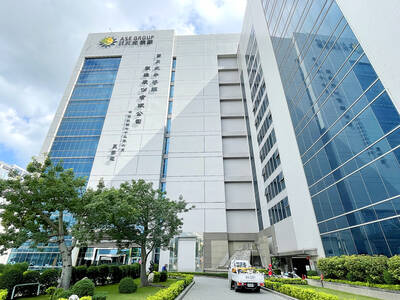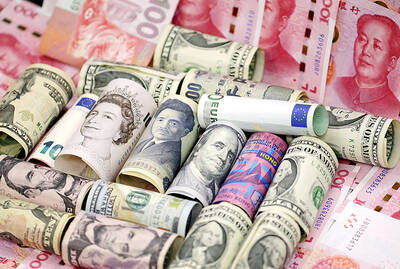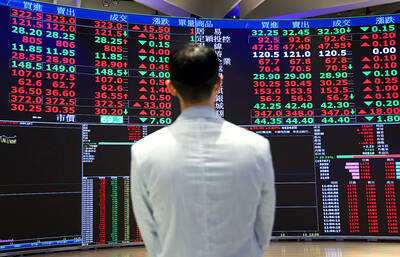As of Monday, a total of NT$38 billion (US$1.1 billion) in consumer vouchers had been cashed, or 46.7 percent of the amount distributed by the government, and 97 percent of the nation’s population had already collected their vouchers, Council for Economic Planning and Development (CEPD) Chairman Chen Tian-jy (陳添枝) said in a keynote speech to a business group yesterday.
“Within a month, nearly half of the vouchers have been cashed, which proves that the policy works pretty well,” he said, expressing his satisfaction over the program.
It is too early to tell how effectively the vouchers have spurred domestic demand by the so-called “multiplier effect” since consumers have until the end of September to spend the remaining NT$47 billion.

PHOTO: TSAI TSONG-HSIAN, TAIPEI TIMES
But Chen said the council was happy to learn of “good signs,” such as 70 percent of the revenues Grand Formosa Taroko Hotel (天祥晶華) in Hualien received during the Lunar New Year vacation were paid by vouchers.
The vouchers seem to have been effective in boosting domestic tourism, Chen said.
The government started distributing NT$85.7 billion in consumer vouchers — or NT$3,600 per qualified individual — on Jan. 18, hoping the program could add 0.66 percentage points to the GDP this year.
The economist-turned-government official said there was little the government could do to fix the nation’s export-dependent economy since externally, “the world has stopped buying with the collapse in demand.”
Other than domestic consumption, private investment is also crucial to lifting the local economy, Chen said.
However, private investment will be hard pressed to rise until there are signs that the economy is beginning to recover.
Chen expressed concern over a huge decline of between 30 percent and 40 percent in private investment last quarter, which spelled bad news for the economy, he said.
Chen did not specify in his speech whether the decline was on a quarterly or annual basis.
The Directorate-General of Budget, Accounting and Statistics reported yesterday evening that private investment in the fourth quarter dropped 32.2 percent from a year earlier.
Against this backdrop, Chen called on the nation’s private banking sector to refrain from tightening credit to businesses, especially as the government has already provided a blanket deposit guarantee to help ease the sector’s liquidity crisis.
In response, Charles Lo (羅聯福), chairman of Chinatrust Commercial Bank (中國信託商銀), said the government should shoulder more responsibility to tend to the credit risks that the sector may be facing given the global economic crisis.
It is impossible for the nation’s 15 financial holding companies, which only reported more than NT$10 billion in profits last year, to help meet the government’s goal of granting NT$600 billion in loans to businesses, Lo said.
Instead, Lo urged the government to be “more aggressive” and establish a credit fund of at least NT$100 billion, which he believed would create a multiplier effect of 10 times for domestic banks to release NT$1 trillion in loans to the business sector.

EXPANSION: The investment came as ASE in July told investors it would accelerate capacity growth to mitigate supply issues, and would boost spending by 16 percent ASE Technology Holding Co (ASE, 日月光投控), the world’s biggest chip assembly and testing service provider, yesterday said it is investing NT$17.6 billion (US$578.6 million) to build a new advanced chip packaging facility in Kaohsiung to cope with fast-growing demand from artificial intelligence (AI), high-performance-computing (HPC) and automotive applications. The new fab, called K18B, is to commence operation in the first quarter of 2028, offering chip-on-wafer-on-substrate (CoWoS) chip packaging and final testing services, ASE said in a statement. The fab is to create 2,000 new jobs upon its completion, ASE said. A wide spectrum of system-level chip packaging technologies would be available at

Taiwan’s foreign exchange reserves hit a record high at the end of last month, surpassing the US$600 billion mark for the first time, the central bank said yesterday. Last month, the country’s foreign exchange reserves rose US$5.51 billion from a month earlier to reach US$602.94 billion due to an increase in returns from the central bank’s portfolio management, the movement of other foreign currencies in the portfolio against the US dollar and the bank’s efforts to smooth the volatility of the New Taiwan dollar. Department of Foreign Exchange Director-General Eugene Tsai (蔡炯民)said a rate cut cycle launched by the US Federal Reserve

HEAVYWEIGHT: The TAIEX ended up 382.67 points, with about 280 of those points contributed by TSMC shares alone, which rose 2.56 percent to close at NT$1,400 Shares in Taiwan broke records at the end of yesterday’s session after contract chipmaker Taiwan Semiconductor Manufacturing Co (TSMC, 台積電) hit a fresh closing-high amid enthusiasm toward artificial intelligence (AI) development, dealers said. The TAIEX ended up 382.67 points, or 1.45 percent, at the day’s high of 26,761.06. Turnover totaled NT$463.09 billion (US$15.22 billion). “The local main board has repeatedly hit new closing highs in the past few sessions as investors continued to embrace high hopes about AI applications, taking cues from a strong showing in shares of US-based AI chip designer Nvidia Corp,” Hua Nan Securities Co (華南永昌證券) analyst Kevin Su

Nvidia Corp’s major server production partner Hon Hai Precision Industry Co (鴻海精密) reported 10.99 percent year-on-year growth in quarterly sales, signaling healthy demand for artificial intelligence (AI) infrastructure. Revenue totaled NT$2.06 trillion (US$67.72 billion) in the last quarter, in line with analysts’ projections, a company statement said. On a quarterly basis, revenue was up 14.47 percent. Hon Hai’s businesses cover four primary product segments: cloud and networking, smart consumer electronics, computing, and components and other products. Last quarter, “cloud and networking products delivered strong growth, components and other products demonstrated significant growth, while smart consumer electronics and computing products slightly declined,” compared with the